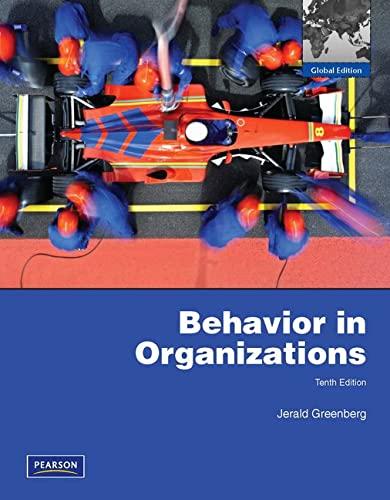What happens when people who might ordinarily come into contact with one another on their jobs no
Question:
What happens when people who might ordinarily come into contact with one another on their jobs no longer have that social contact? Several things may happen. For example, when employees do not see each other on a regular basis, it is difficult to build the team spirit that is needed to establish quality goods and services in some organizations. As a result, telecommuting does not lend itself to all jobs and to all individuals. This exercise will help you determine if you and members of your work team are ready for telecommuting.
Directions Working independently, each member of a work team should complete the following questionnaire by indicating the extent to which each statement describes his or her own characteristics or current job situation.
1 = not at all 2 = slightly 3 = moderately 4 = somewhat 5 = greatly Scale To what extent . . .
1. Does your job allow you to work independently of others?
2. Is it important for you to see the people with whom you work face-to-face?
3. Are you able to complete jobs without being watched closely?
4. Are you comfortable using computers and high-tech equipment?
5. Is your company able to train you to use technology to do your job?
6. Are you able to manage your own time effectively?
7. Are you capable of finding a safe, secure, and nondistracting place to work?
8. Does your job performance depend on measurable aspects of your individual performance?
9. Would you miss the socializing that goes on in the office if you were away from it?
10. Is it possible for you to have access to the equipment and supplies needed to do your job while away from the office?
Scoring and Interpretation 1. Add together your scores for items 1, 3, 4, 5, 6, 7, 8, and 10.
2. Add together your scores for items 2 and 9. Subtract this sum from 12.
3. Add together the number from step 1 and the number from step 2. You will get a number from 10 to 50. This is your individual score.
4. Higher scores reflect higher degrees of individual readiness for telecommuting. Scores of 15 or lower reflect low degrees of readiness. Scores of 35 or higher reflect high degrees of readiness.
5. Add together the individual scores from all the members of your team. Then divide this number by the number of people in your team. This is your team’s average readiness for telecommuting score.
6. Higher scores in step 5 reflect higher degrees of team readiness for telecommuting. Scores of 15 or lower reflect low degrees of team readiness. Scores of 35 or higher reflect high degrees of team readiness.
Questions for Discussion
1. In scoring the scale responses, why do you think questions 2 and 9 were treated differently from the others? How are they different?
2. Does your individual score (step 4) suggest that you are ready for telecommuting? Do you do so already? Might it be possible to telecommute some of the time if you are not doing so already?
3. Does your team score (step 6) suggest that your team is ready for telecommuting? Do some members of the team engage in telecommuting already? If so, how are the other members of the work team affected by this? If not, why do you think this is not already going on?
Step by Step Answer:






